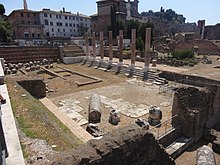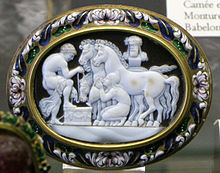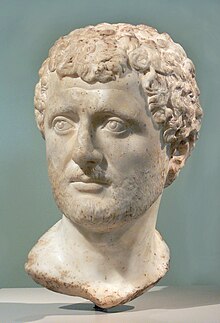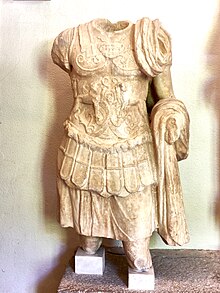Art collection in ancient Rome was a common practice amongst the ancient Romans. Goods and artworks had symbolic meanings and were used to convey messages about the collector and the Roman state. Due to the popularity of collectable goods an art market sprouted up. These goods were managed at first by the aediles and censors, and later by the curatores aedium sacrarum et operum locorumque. Lists may also have been used to track goods.
Public collections

Ancient Roman temples were ornamented with artworks depicting events from Roman mythology and history. In the Early Roman Empire, Greek statues and sculptures were popular decorations for Roman temples.[1] Macrobius, a 5th-century Roman author, explains that objects in temples can be divided into two categories: decorations and sacred objects. He claims that the difference between these groups is the day in which they are dedicated to the god: decorations were not dedicated on the same day the temple was sanctified, whereas religious objects were sanctified on the same day as the temple.[2] The Lindos Chronicle, a Hellenistic document dated to 99 BCE, catalogues the donations made to the Temple of Athena Lindia prior to the temple's destruction around 392-391 BCE.[3] Cicero, a 1st-century BCE Roman politician, in the series of speeches In Verrem claims that Publius Servilius documented the loot of his conquests in public tablets and registers stored in the treasury.[4][5]
Decorative items projected the power of the local city and functioned as sources of communal pride.[6] According to the 2nd-century Greek geographer Pausanias, a temple in Chaeronea housed a scepter allegedly held by Agamemnon and forged by Hephaestus. Pausanias claims that this artifact was much venerated by the locals and brought fame to the city.[7] Cicero claims that religious artwork depicting the history of Sicilly, which was displayed in a temple of Minerva, was intricately designed and that "there was nothing at Syracuse that was thought more worthy going to see."[3][5] Objects of religious or cultural significance became highly sought-after by collectors; Emperor Caracalla—according to the 3rd-century Roman historian Cassius Dio—collected drinking cups and weapons he believed were once owned by Alexander the Great.[8][6] The aediles, who were political officials in ancient Rome, established art exhibitions for religious festivals.[9][10] Cicero describes an aedile named Gnaeus Claudius who utilized a marble statue of Cupid in an art display honoring the Roman deities.[11][9] During the reign of Augustus, the newly established office of Curatores aedium sacrarum subsumed the responsibility of managing public collections.[4]
Generals publicly showcased loot from their wars, hoping to utilize art displays as political propaganda.[9][10] Usually, looted objects were displayed in the capital city during a triumph.[12] This was an important religious and political rite; it highlighted the achievements of the triumphing general.[13] Gaius Asinius Pollio reconstructed the Atrium Libertatis, decorating it with loot from his military campaign in Illyria.[14][15] Emperor Vespasian constructed the Temple of Peace which showcased the loot he gained from his war in Judea.[4] Loot was also displayed in important locations throughout the city of Rome such as the Campus Martius or the Forum.[9] During the 5th century, Lausos—a court eunuch of Theodosius II—organized a public display of various cult statues. These statues depicted figures from traditional Roman paganism; these works were likely acquired from existing Roman temples that were likely abandoned due to the rise of Christianity.[16] In the Theodosian Code, Emperor Constantine decreed that a temple—likely in Edessa—should remain open despite its pagan origins to ensure the residents of the city could continue to view the artwork on display, although Constantine forbid the practice of sacrifice in this temple.[17][18] During sieges and battles, the Roman military performed a ritual known as evocatio.[19] This practice was designed to divert the opposing's sides patron deities to the Roman side. As part of this practice, religious idols and statues may have been taken from the opposing culture to the Roman cities.[13]
Important historical and cultural sites were also maintained and put on display. The birthplace and house of Romulus were preserved and publicly displayed on the Palatine hill.[20] It may have been located on the Capitoline Hill. However, this structure may have been a copy of the one on the Palatine hill. Emperors and generals commemorated their successes through the construction of monuments such as the Arch of Constantine, which were designed to publicly showcase the notability of a person's achievements.[18] Through these forms of public display artworks gained new meaning. To the Romans, they were representative of the Roman state's triumph over their enemies.[21] Another kind involved the creation of movable paintings. To create this, marble was inserted in niches in the stonework. Frescoes were used to decorate the walls of an oecus or cryptoporticus.[22]
Private collections
Aside from public spaces, the Romans stored art collections within their own houses and villas.[23] It was considered a sign of high social status to have many visitors come to see the artwork in one's house.[24][25] There were numerous methods of displaying works in ancient Rome. One method of displaying works was the Pinacothecae. It was a kind of picture gallery where paintings were painted on marble or wood panels.[26][27] They became popular in the mid-1st century BCE.[28] The 1st-century BCE Roman orator Quintus Hortensius reportedly paid 144,000 sesterces for a painting of the Argonauts made by the 4th-century BCE Greek painter Cydias; he later constructed a shrine in his villa to hold this painting.[23][29] According to Diodorus Siculus, a 1st-century BCE Greek historian, the many of the wealthy citizens of Agrigentum were habitual collectors of expensive and sublime art. Diodorus further records that the Carthaginian general Hamilcar Barca looted much of this artwork during the First Punic War in the 3rd-century BCE.[30][18] In Alexandria and Pergamon, private collections were stored in libraries, the atria of libraries, gardens, banquet halls, and royal palaces.[31][32] These collections were heavily influenced by Hellenism,[33] collectors were motivated by their respect and deference for Greek culture.[18] Gaius Asinius Pollio amassed a sizeable private collection of Greek sculptures and art; he displayed this collection publicly because, according to the 1st-century CE Roman writer Pliny the Elder, he was "was accordingly anxious for his collection to attract sightseers."[34][35] Livy, a 1st-century BCE Roman historian, stated that the Roman passion for collecting Greek artwork originated from the capture of Syracuse in 211 BCE. He claims that following the conquest of Syracuse, large quantities of Greek art flowed into Rome as the spoils of war; this loot then began to be collected by the Romans.[36][37] Livy viewed this obsession with Hellenism negatively, calling the statues looted from Syracuse "tokens of danger" and "allurements of vice." He warned his readers, "the more I fear that these things [Greek artwork] will capture us rather than we them."[38][37] Loot from other conquests became sought after by Roman collectors; ebony was sent to Rome following the defeat of Mithridates in 66 BCE and Lucius Scipio exported chased silverware and golden vessels to Rome after his conquest of Asia in 189 BCE.[39][40][37]
Engraved gems

A popular, and conveniently portable, type of object collected was the engraved gem. Many Greek and Hellenistic artists were very well-known and sought after. Famous collectors begin with King Mithridates VI of Pontus (d. 63 BC), whose collection was part of the booty of Pompey the Great, who donated it to the Temple of Jupiter in Rome.[41] Julius Caesar was determined to excel Pompey in this as in other areas, and later gave six collections to his own Temple of Venus Genetrix; according to Suetonius gems were among his varied collecting passions.[42] Many later emperors also collected gems. Chapters 4-6 of Book 37 of the Natural History of Pliny the Elder give a summary art history of the Greek and Roman tradition, and of Roman collecting. According to Pliny Marcus Aemilius Scaurus, praetor in 56 BC, was the first Roman collector.[43]
Cultural significance

The objects the Romans liked to collect often had a symbolic purpose.[44] Cicero viewed one's material possessions as an extension of oneself.[32] Patricians would collect wax figures of their ancestors and use them to decorate their houses and during funeral services.[45][46] Portraits of famous figures would also be collected. These artworks were status symbols and were used to showcase moral virtues.[35][47] Collected objects often represented the past and the achievements and identity of Rome. Collections were used to convey messages about the collector and Roman society at large. Cicero described his political opponent, Verres, as an unvirtuous collector. Verres was described as a person obsessed with other's perceptions of himself, and with a lust for art pieces.[48]
For Roman women, two stereotypes existed: The good, "honourable" women who were associated with "the house, piety and religion", who would only collect objects needed for "the adornments of the house, or religious practices."[33] And on the other hand, the "frivolous, vain, time-wasting" women who would acquire "objects of personal adornment" in order to seduce men.[33] Sometimes, women used the male population's desires for goods such as citron tables as a defense against accusations of extravagance in pearls.[49]

Objects and artworks could become expensive and valuable due to the cultural significance attached to them. The art market expanded to allow for intentionally collectable goods and art pieces designed to follow cultural and artistic trends. Pliny the Elder uses the term insania to describe the populace's affinity for citron tables.[50][49] Despite the name, these "citron" tables were likely actually made of the Tetraclinis tree.[51][52] Pliny also describes how the orator Lucius Crassus had cups so valuable he had never used them. He was said to have paid 100,000 sesterces for two of these cups.[53][54] Silverware were common materials to collect,[55] and they were considered a sign of high social status, with one ex-consul spending 70,000 sesterces on a murrhine goblet.[33] Other commonly collected materials included jewelry, carpets, books, and furniture. Artworks and goods were sold in areas such as the forum. Some Romans considered the love of goods and the desire to collect objects to be immoral. Agrippa, inspired by one of Cato's speeches,[22] stated that artwork should not be held by private individuals but instead returned to the populace.[56][57][58] The artist's signature was important for determining the value of an artwork. It was equivalent to a modern brand name. Forgers would fake signatures to inflate the price of an art piece. Merchants would sell goods under the pretense that they belonged to mythological or important cultural figures, such as if they were the clothes of Odysseus.[59]
Administration
Augustus established the curatores aedium sacrarum et operum locorumque publicorum, which was a group of two individuals tasked with managing architecture and public art.[60][61][62] This organization's role was previously filled by the censors and the aediles.[4][63] It is possible that artworks and artifacts were tracked with inventory lists of works in collections or on public display. These lists would have been called litterae publicae.[64] Statues may have been identified based on inscriptions that identified where they were located in the lists. These inscriptions would have abbreviations that showcased the text's volume, the column of the work, and its number.[21]
References
- ^ Strong 1988, p. 48.
- ^ Macrobius. Saturnalia. 3.11.6.
- ^ a b Gahtan & Pegazzano 2014, p. 3.
- ^ a b c d Gahtan & Pegazzano 2014, p. 7.
- ^ a b Cicero. In Verrem. 1.21.
- ^ a b Gahtan & Pegazzano 2014, p. 2.
- ^ Pausanias. Description of Greece. 9.40.11.
- ^ Cassius Dio. Roman history. 78.7.
- ^ a b c d Gahtan & Pegazzano 2014, p. 5.
- ^ a b "A Monumental Imperial Biography - Archaeology Magazine". www.archaeology.org. Retrieved 2022-08-18.
- ^ Cicero. In Verrem. 4.3.
- ^ Marconi 2014, p. 378.
- ^ a b Marconi 2014, p. 377.
- ^ Gahtan & Pegazzano 2014, p. 6.
- ^ Gaius Suetonius Tranquillus. De vita Caesarum, Aug. 29.
- ^ Gahtan & Pegazzano 2014, p. 8.
- ^ Codex Theodosianus. 16.10.8.
- ^ a b c d Gahtan & Pegazzano 2014, p. 9.
- ^ Beard 1998, p. 41.
- ^ Rutledge 2012, p. 166.
- ^ a b Liverani 2014, pp. 72–78.
- ^ a b Ghedini & Salvo 2014, pp. 109–118.
- ^ a b Gahtan & Pegazzano 2014, p. 13.
- ^ Lockey, Ian (2009). "Roman Housing". Heilbrunn Timeline of Art History. New York: The Metropolitan Museum of Art.
- ^ Haines, T. L. (Thomas Louis); Yaggy, L. W. (Levi W. ) (1884). Museum of Antiquity: A Description of Ancient Life. Madison, Wisconsin, and Chicago, Illinois: J.B. FURMAN & CO. WESTERN PUBLISHING HOUSE.
- ^ Squire 2010, p. 135.
- ^ Clarke 2001, p. 163.
- ^ Smith 2018, pp. 1–9.
- ^ Pliny. Nautralis Historia. 35. 40.
- ^ Diodorus Siculus. Bibliotheca Historia. 13.90.3.
- ^ Neudecker 2014, pp. 129–132.
- ^ a b Jones 2014, p. 794.
- ^ a b c d Mastrorosa 2014, pp. 102–109.
- ^ Pliny the Elder. Naturalis Historia. 36.4.
- ^ a b Gahtan & Pegazzano 2014, p. 11.
- ^ Livy. Ab Urbe Condita. 25.40.
- ^ a b c Gahtan & Pegazzano 2014, p. 12.
- ^ Livy. Ab Urbe Condita. 34.4.3.
- ^ Pliny. Naturalis Historia. 12.9.
- ^ Pliny. Naturalis Historia. 33.53.
- ^ Pliny, see below. Whether he was right to claim Mithridates as the first collector is dubious.
- ^ De Vita Caesarum, Divus Iulius, (The Lives of the Caesars, The Deified Julius), Fordham online text
- ^ Pliny, Natural History, xxxvii.5
- ^ Stirling 2014, pp. 137–146.
- ^ One or more of the preceding sentences incorporates text from a publication now in the public domain: Chisholm, Hugh, ed. (1911). "Wax Figures". Encyclopædia Britannica. Vol. 28 (11th ed.). Cambridge University Press. p. 430.
- ^ Pilbeam 2006, p. 1.
- ^ Syson & Thornton 2001, p. 78.
- ^ Pearce 2013, p. 93.
- ^ a b Ulrich 2007, p. 248.
- ^ Evers 2017, p. 17.
- ^ Gahtan & Pegazzano 2014, pp. 102–103.
- ^ "Definition of ALERCE".
- ^ Casement 2022, p. 218.
- ^ Mommsen 2008, p. 322.
- ^ Tilley et al. 2006, p. 536.
- ^ Jones 2014b, pp. 118–129.
- ^ Tucci 2017, p. 466.
- ^ Dyson 2010, p. 141.
- ^ Belk 2013, p. 23.
- ^ Berger 2002, p. 421.
- ^ Boatwright 2021, p. 21.
- ^ Dunstan 2010, p. 227.
- ^ Rawson 2003, p. 287.
- ^ Meyer 2004, p. 226.
Bibliography
- Beard, Mary (1998). Religions of Rome. Cambridge University Press. ISBN 978-0-521-30401-6.
- Berger, Adolf (2002). Encyclopedic Dictionary of Roman Law. The Lawbook Exchange, Ltd. ISBN 978-1-58477-142-5.
- Belk, Russell W. (2013-01-11). Collecting in a Consumer Society. Routledge. ISBN 978-1-134-57599-2.
- Boatwright, Mary Taliaferro (2021-01-12). Hadrian and the City of Rome. Princeton University Press. ISBN 978-0-691-22402-2.
- Casement, William (2022-04-17). The Many Faces of Art Forgery: From the Dark Side to Shades of Gray. Rowman & Littlefield. ISBN 978-1-5381-5801-2.
- Clarke, Michael (2001). The concise Oxford dictionary of art terms. Oxford University Press. ISBN 978-0-19-280043-5.
- Dunstan, William E. (2010-11-16). Ancient Rome. Rowman & Littlefield Publishers. ISBN 978-0-7425-6834-1.
- Dyson, Stephen L. (2010-06-14). Rome: A Living Portrait of an Ancient City. JHU Press. ISBN 978-1-4214-0101-0.
- Evers, Kasper Grønlund (2017). Worlds Apart Trading Together: The organisation of long-distance trade between Rome and India in Antiquity. Archaeopress.
- Gahtan, Maia Wellington; Pegazzano, Donatella (2014-01-01), "Museum Archetypes and Collecting: An Overview of the Public, Private, and Virtual Collections of the Ancient World", Museum Archetypes and Collecting in the Ancient World, BRILL, pp. 1–18, ISBN 978-90-04-28050-2, retrieved 2024-07-24
- Ghedini, Francesca; Salvo, Giulia (2014-01-01), "Private Art Galleries in Roma: Literary and Archaeological Evidence", Museum Archetypes and Collecting in the Ancient World, Brill, pp. 109–117, ISBN 978-90-04-28348-0, retrieved 2024-07-24
- Jones, Nathaniel (2014b), "Temple Inventory and Fictive Picture Gallery: Ancient Painting between Votive Offering and Artwork", Museum Archetypes and Collecting in the Ancient World, Brill, pp. 118–128, ISBN 978-90-04-28348-0, retrieved 2024-07-24
- Jones, F. M. A. (2014-08-19). "Roman Gardens, Imagination, and Cognitive Structure". Mnemosyne. 67 (5): 781–812. doi:10.1163/1568525X-12341369. ISSN 0026-7074.
- Liverani, Paolo (2014-01-01), "The Culture of Collecting in Roma: Between Politics and Administration", Museum Archetypes and Collecting in the Ancient World, Brill, pp. 72–77, ISBN 978-90-04-28348-0, retrieved 2024-07-24
- Marconi, Clemente (2014-10-07). The Oxford Handbook of Greek and Roman Art and Architecture. Oxford University Press. ISBN 978-0-19-979052-4.
- Mastrorosa, Ida Gilda (2014-01-01), "Collectables, Antiques and Sumptuary Trends in Ancient Roma: A Look around the Dining Halls of the Late Republic and Early Empire", Museum Archetypes and Collecting in the Ancient World, Brill, pp. 102–108, ISBN 978-90-04-28348-0, retrieved 2024-07-24
- Meyer, Elizabeth A. (2004-02-12). Legitimacy and Law in the Roman World: Tabulae in Roman Belief and Practice. Cambridge University Press. ISBN 978-1-139-44911-3.
- Mommsen, Theodor (2008-03-01). Mommsen's History of Rome. Wildside Press LLC. ISBN 978-1-4344-6232-9.
- Neudecker, Richard (2014-01-01), "Collecting Culture: Statues and Fragments in Roman Gardens", Museum Archetypes and Collecting in the Ancient World, Brill, pp. 129–136, ISBN 978-90-04-28348-0, retrieved 2024-07-24
- Pearce, Susan (2013-10-28). On Collecting: An Investigation into Collecting in the European Tradition. Routledge. ISBN 978-1-135-90809-6.
- Pilbeam, Pamela (2006-08-10). Madame Tussaud: And the History of Waxworks. A&C Black. ISBN 978-1-85285-511-6.
- Rawson, Beryl (2003). Children and Childhood in Roman Italy. Oxford University Press. ISBN 978-0-19-924034-0.
- Rutledge, Steven (2012-04-26). Ancient Rome as a Museum: Power, Identity, and the Culture of Collecting. Oxford University Press. ISBN 978-0-19-957323-3.
- Smith, Reagan A. (2018). "Ancient Roman Spaces that Served as Museums". Berkeley Undergraduate Journal of Classics. 6 (2).
- Squire, Michael (2010). "Introduction: The Art of Art History in Greco-Roman Antiquity". Arethusa. 43 (2): 133–163. ISSN 1080-6504.
- Strong, Donald Emrys (1988). Roman art. Yale University Press. ISBN 978-0-300-05293-0.
- Stirling, Lea (2014-01-01), "The Opportunistic Collector: Sources of Statuary Décor and the Nature of Late Antique Collecting", Museum Archetypes and Collecting in the Ancient World, Brill, pp. 137–145, ISBN 978-90-04-28348-0, retrieved 2024-07-24
- Syson, Luke; Thornton, Dora (2001). Objects of Virtue: Art in Renaissance Italy. Getty Publications. ISBN 978-0-89236-657-6.
- Tilley, Chris; Keane, Webb; Kuechler, Susanne; Rowlands, Mike; Spyer, Patricia (2006-01-05). Handbook of Material Culture. SAGE. ISBN 978-1-4462-0643-0.
- Tucci, Pier Luigi (2017-11-16). The Temple of Peace in Rome. Cambridge University Press. ISBN 978-1-108-54881-6.
- Ulrich, Roger Bradley (2007-01-01). Roman Woodworking. Yale University Press. ISBN 978-0-300-10341-0.


Recent Comments